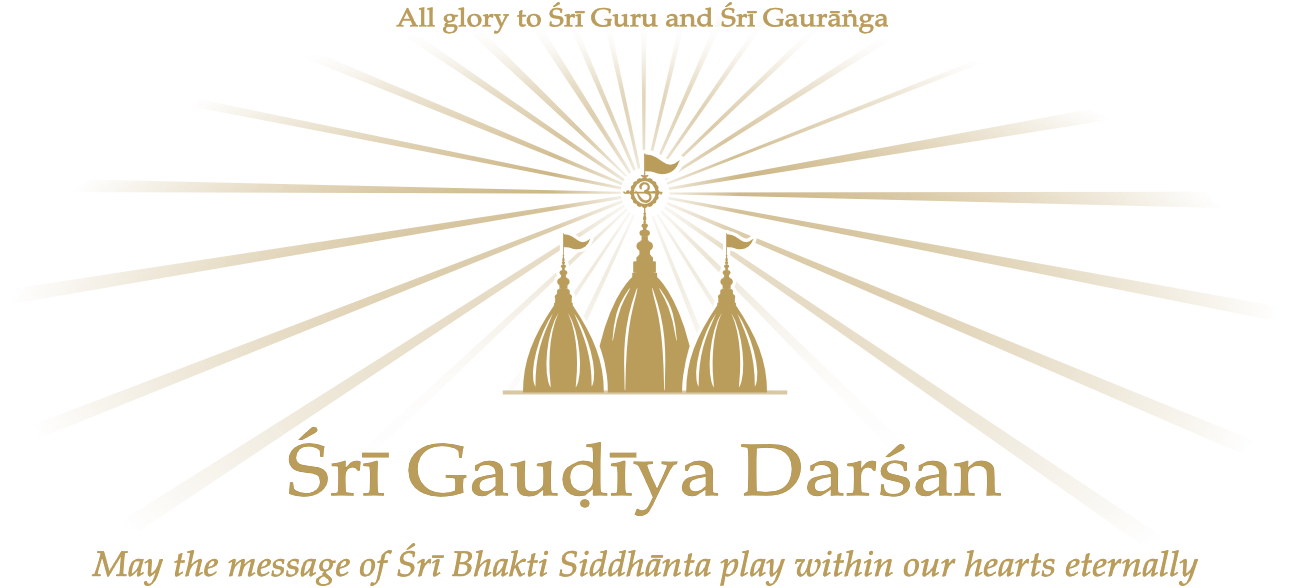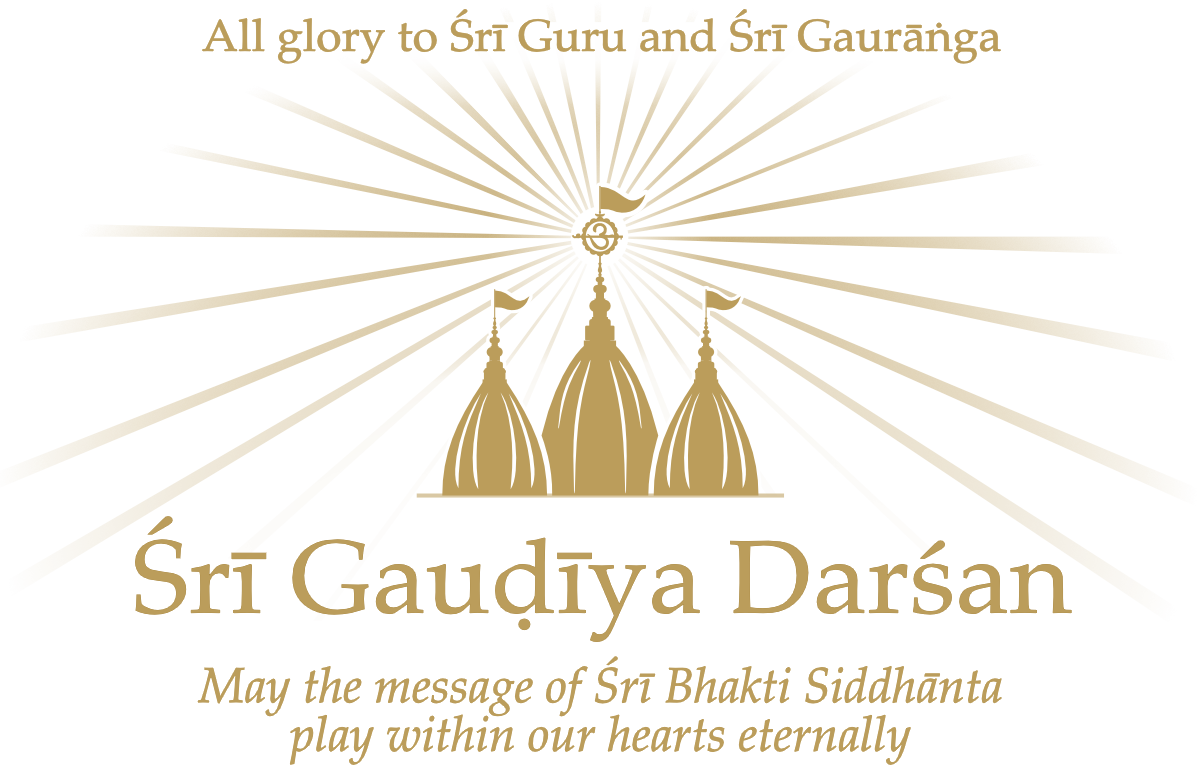Śrīla Bhakti Rakṣak Śrīdhar Dev-Goswāmī Mahārāj explains why Śrī Jagannāthdev’s Ratha Yātrā is not conducted in Vṛndāvan or Nabadwīp.
Śrī Ratha Yātrāya Śrī Rūpānugānuchintana
The Conception of Śrī Ratha Yātrā According to the Followers of Śrī Rūpa
Śrīla Bhakti Rakṣak Śrīdhar Dev-Goswāmī Mahārāj
Published in the pen name of
Upadeśaka Paṇḍit Śrī Kṛṣṇa Govinda Dās Adhikārī Bhakti Kovinda
in Śrī Gauḍīya Darśan, Volume 13, Issue 1,
on Sunday, 24 August 1969.
This year in Śrī Puruṣottam, although there was a larger assembly of devotees in honour of the occasion of Nava-kalevara, the Ratha Yātrā festival was observed more or less without hindrance.
Since the Avatār of divine love, Lord Śrī Kṛṣṇa Chaitanyadev, revealed His Pastime of dancing and chanting at the Ratha Yātrā of Śrī Jagannāth, the followers of Śrī Gauḍīya-darśan [the adherents of the Gauḍīya Vaiṣṇava worldview] have deepened their angle of vision into this Pastime. Taking shelter in Śrī Kṛṣṇa’s assuring words found in Śrīmad Bhāgavatam—bhavatīnāṁ Mad-āpanaḥ [“Your surety of meeting Me”]—the residents of Vraja relish the festival of joy produced by the gopīs reuniting with Śrī Kṛṣṇa after prolonged separation during the Pastime of the Lord’s journey from Śrī Nīlāchal (Dvārakā) to Śrī Sundarāchal (Śrī Vṛndāvan), representing Him journeying from Śrī Dvārakā Dhām to Śrī Vṛndāvan. Like the satisfaction of eating after intense hunger, this grand meeting in Śrī Vraja Dhām with the gopīs’ beloved after extremely long, extremely intense separation causes a flood of unprecedented and unparalleled nectar (rasa) within Vraja.
Following this, devotees who relish rasa, to develop their bhajan (service), have arranged the Pastime of Ratha Yātrā in many places in a material form to uplift the public and side by side augment their own bhajan. Throughout Odisha, and in the examples of Māheś and others in Bengal, this is clearly evident.
Enactment of this Pastime is, however, not seen in Śrī Vṛndāvan. Akrūra brought a chariot to Vṛndāvan from Mathurā and took Śrī Kṛṣṇa and Balarām away. The impression produced by this causes dreadful fear to arise in the hearts of the gopīs at the sight of a chariot. Later, the morning after Śrī Uddhava arrived in Śrī Vṛndāvan in a chariot in the dark at dust after being sent by Śrī Kṛṣṇa to collect news of the gopīs’ well-being, intense fear and extremely intense sorrow was apparent in the words of the gopīs at the sight of the chariot: “Has Akrūra come here again to collect our flesh for the satisfaction of his departed master (for the śrāddha of dead Kaṁsa)?” Thus, because the sight of a chariot causes extremely intense pain in the hearts of the gopīs, this Pastime is not seen to be enacted in Vṛndāvan.
Many great souls who are adept in the Lord’s service are also known to reside in Śrī Nabadwīp Dhām, which is nondifferent from Vraja Maṇḍal. Still today, however, no such great souls have been seen to endeavour to enact the Pastime of Śrī Ratha Yātrā to develop their bhajan. What more, even at Śrī Jagannāth Kṣetra within a part of Śrī Nabadwīp Dhām (Śaraḍāṅgā, where a form of Śrī Jagannāth resides), we have never seen the custom of enacting Śrī Ratha Yātrā.
In this regard, it must be asked, is such an endeavour to gather the public in Māyāpur of Śrī Nabadwīp Dhām—the hidden form of Vṛndāvan—favourable to bhajan or preaching? Is it possible for those who are engaged in bhajan in the Holy Dhām, those who are engaged in the practice of devotion on the basis of theological truths (sambandha-jñān), to see or try to see Dvārakā here and there within the Holy Dhām? Consider, by organising a Ratha Yātrā, can the Lord be taken from what is seen by great souls to be Gokula or Govardhan within Śrī Nabadwīp Dhām to Śaraḍāṅgā in Jagannāth Kṣetra or Harihara Kṣetra?
Ṭhākur Bhakti Vinod made known the principle of “related means” regarding entering the Dhām. Although Bhakti Vinod Ṭhākur organised fairs and showed many other endeavours to gather the public to broadcast the discovery of Śrīman Mahāprabhu’s birthplace as was favourable for preaching, he did not start a Ratha Yātrā. And even amongst Viśva Guru Bhagavān Śrīla Bhakti Siddhānta Saraswatī Prabhupād’s tremendous, comprehensive, and diverse endeavours to spread the message of Śrī Gaura, a Pastime of conducting a Ratha Yātrā in Śrī Gaura Dhām was not shown. Is the reason for this that it is not a subject of interest for pure devotees who are interested in bhajan?
Certainly, according to the path of proper conduct, a Pastime of Deities travelling in chariots at any time here [in Śrī Nabadwīp Dhām] is out of place. In this regard, Śrīla Prabhupād’s own expression is, “Pūjala rāga-patha gaurava-bhaṅge [worship the path of love in a posture of reverence].”
Regarding the meaning of Ratha Yātrā on the path shown by Śrīman Mahāprabhu, Śrī Rūpa Pād’s vision is,
priyaḥ so ’yaṁ kṛṣṇaḥ sahachari kurukṣetra-militas
tathāhaṁ sā rādhā tad idam ubhayoḥ saṅgama-sukham
tathāpy antaḥ-khelan-madhura-muralī-pañchama-juṣe
mano me kālindī-pulina-vipināya spṛhayati
[“O friend, I have met My beloved, Kṛṣṇa, in Kurukṣetra. I am the same Rādhā, and We are both pleased by Our reunion. Still, My heart desires to hear the fifth note of His sweet flute beneath the trees on the banks of the Yamunā.”]
This is the vision that augments the bhajan of the followers of Śrī Rūpa.
Background
Śrīla Bhakti Sundar Govinda Dev-Goswāmī Mahārāj’s explanation of the purpose of this article is found in chapter twenty-five of Affectionate Guidance:
Śrīla Guru Mahārāj from time to time gave an article [to Śrī Gauḍīya Darśan magazine]. One such article was entitled Śrī Ratha Yātrāya Śrī Rūpānugānuchintana. This explained what the followers of Śrīla Rūpa Goswāmī will think about the Ratha Yātrā.
At that time, the Māyāpur Śrī Chaitanya Maṭh started a Ratha Yātrā, but that was very painful for Śrīla Guru Mahārāj because it was offensive to the Rūpānuga-chintadhārā. This is very high siddhānta. Mahāprabhu explained that the meaning of Ratha Yātrā is that Śrīmatī Rādhārāṇī takes Kṛṣṇa from Kurukṣetra to Vṛndāvan. But Māyāpur is the birthplace of Mahāprabhu who is nondifferent from Kṛṣṇa. So from Māyāpur, where are they taking Mahāprabhu? They cannot take Kṛṣṇa out of Vṛndāvan, nor can they take Mahāprabhu out of Māyāpur. This is the thinking of the Rūpānuga followers, and this was explained in that article by Śrīla Guru Mahārāj. However, I did not give Śrīla Guru Mahārāj’s name as the author because we knew that some other parties may try to contradict this thinking, and if a conflict will come, I shall face that, but I shall not push Śrīla Guru Mahārāj to the front of any conflict. If I put Śrīla Guru Mahārāj’s name and anyone will give any objection, that will be offensive for them, therefore I put the name of one of my godbrothers. We wanted to show everyone what is the proper siddhānta, but in the battlefield we shall not push our Guru to the forefront. I shall go to the battlefield if necessary, but not that I will make my Guru go there.
When the leap month on the lunar calendar, which occurs every two years and eight months and is known as Puruṣottam Mās or Māla Mās, falls in the middle of the month of Āṣāḍh (June-July), in other words, when it falls between Snān Yātrā and Ratha Yātrā, then the festival known as Nava-kalevara (lit. ‘new-form’) is observed in which new Deities of Jagannāth, Baladev, Subhadra, and Sudarśan are prepared from specially selected neem (margosa) trees and the existing Deities are buried. Nava-kalevara occurs at intervals of 8, 11, or 19 years, and in the last century, it was performed in 1912, 1931, 1950, 1969, 1977, and 1996. The next Nava-kalevara ceremony will be in 2015.



Leave a Reply